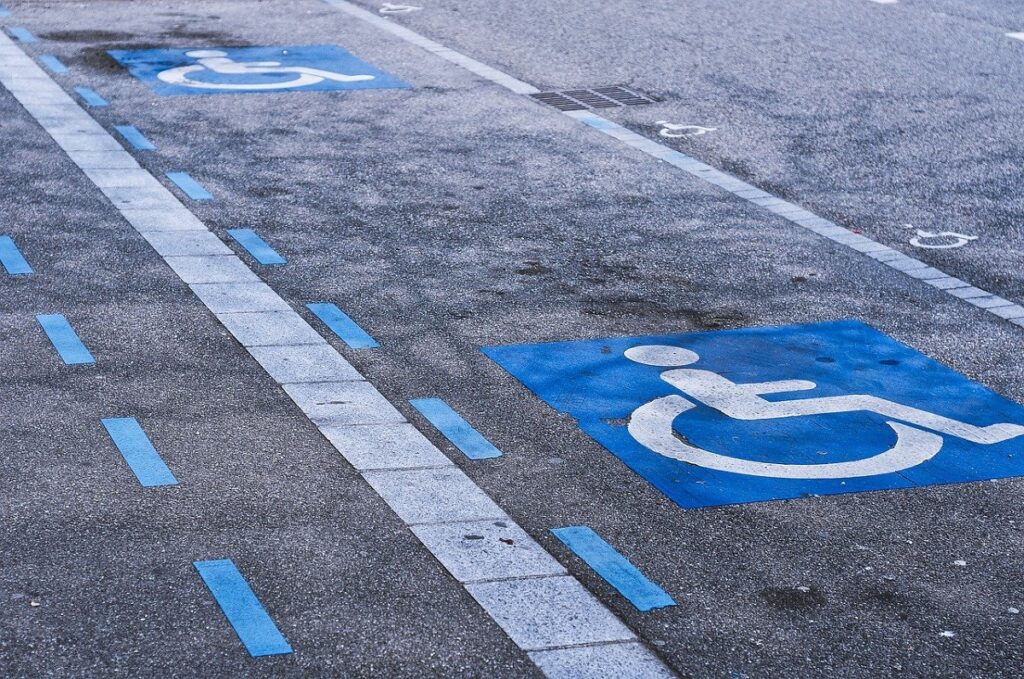Handicap parking bays are essential tools that enable disabled people to go about their business and live their lives to the fullest. Without adequate provision of disabled parking spaces, disabled people may find their freedom curtailed. It is a profoundly unjust situation when an area does not have enough handicap parking bays to serve the needs of the local population.
Federal law covers handicap parking bay regulations, including the minimum number of bays that must be provided in any area. But it is your local government that is responsible for implementing handicap parking regulations in your specific locality.
Every locality is somewhat unique. While federal law can dictate helpful rules of thumb, it is your local government that is responsible for implementing a handicap parking program that is best tailored to the specific needs of your area. So if your area is not adequately provisioned with handicap parking bays, it is your local government that you need to petition.
Below, we’ll look into how to petition your local government for more handicap parking bays, including a handy step-by-step guide.
What Federal Law Deals With Handicap Parking Bay Numbers?
The federal law that deals with handicap parking bay numbers is the Americans With Disabilities Act (ADA). The ADA dictates what the minimum legal number of disabled parking spaces must be in any area. But many areas need more disabled bays than the ADA-dictated minimum requirement.
Disability Act Parking Spaces
All disabled parking spaces in the United States must comply with Americans With Disabilities Act regulations. ADA parking space requirements include the following:
- There should be three types of disabled parking spaces (Accessible Parking Spaces for Cars, Accessible Parking Spaces for Vans with one-sided entry, Accessible Parking Spaces for Vans with two-sided entry).
- Disabled spaces must have a 60-inch-wide aisle (for cars) or 96-inch-wide aisle (for vans).
- Disabled spaces must be clearly signposted.
- Disabled parking spaces must be situated on the shortest accessible route to an accessible entrance to the building or amenity they serve.
- Disabled spaces must make up a certain percentage of the total number of spaces in an area, either on-street or in a parking lot.
- Any area of public on-street parking must include a number of accessible disabled parking spaces, distributed throughout the area.
- Disabled spaces must be located in places with minimum street and sidewalk slope.
- Disabled on-street spaces must be evenly distributed throughout an area, located as close as possible to accessible entrances to buildings and amenities.
Reaching Out To Local Government Representatives
Every area in the country should be adhering to the above ADA regulations. However, even when in keeping with regulations, some localities, for various reasons, still do not have as many handicap bays as they need. If your local area does not have enough handicap parking bays, you can reach out to your local government representatives.
Are Neighborhood Petition Forms Successful?
Neighborhood petition forms are very often successful. If there is a strong desire for positive change amongst the citizens of a local area, a petition to local government will often achieve a good result.

How To Petition County Government For More Disabled Parking Spaces
There are a few steps you should take to make sure that your petition to your local government for more disabled parking spaces is as effective as possible.
Research What Parking Is Available In Your Local Area
The first step is to take a complete inventory of exactly how many disabled parking spaces are in your local area. Work out how many disabled spaces there are relative to non-disabled spaces. Remember, even if the area is ADA-compliant (which it almost certainly will be), it may still not have enough disabled spaces for the specific needs of the populace of the area.
Decide Where There Should Be More Handicap Parking Bays
Decide where exactly the extra handicap bays are most needed. The more specific you can be in your petition, the better.
Find Out Which Department Is Best To Reach Out To
Find out which department of local government, and what people in that department, you need to petition. In some jurisdictions this will be the Department of Motor Vehicles; in others it will be town planning authorities. If you, or anybody you know, has a contact inside local government, it may be best to go through this channel. Remember, local politicians are always interested in attracting new votes!
Call And Write Letters To Local Government Representatives
The first point of contact can be a letter. Clearly and concisely spell out your case and make your requests. Remember, your case is for the good of everyone with disabilities in your community.
If your letter falls on deaf ears, the next method of communication should be a telephone call. There are several reasons why a letter can be put aside, but a phone call is much more immediate and difficult to ignore.
Start A Local Petition
If your letters and phone calls are not having the desired effect, try submitting a written petition with as many signatories as possible. When making a petition, you want to get the word out and invite as many local people to sign it as possible before you submit it. When a petition has a lot of signatories, local government will usually find it impossible to ignore.
Putting together a successful petition can be hard work. You will need to contact a lot of people, either in person or online. But it’ll be worth the effort when your area gets its new disabled parking bays. Good luck!
Before starting a petition, you should have an online medical consultation to first obtain a disabled parking permit. You can do so with Disabled Parking.

